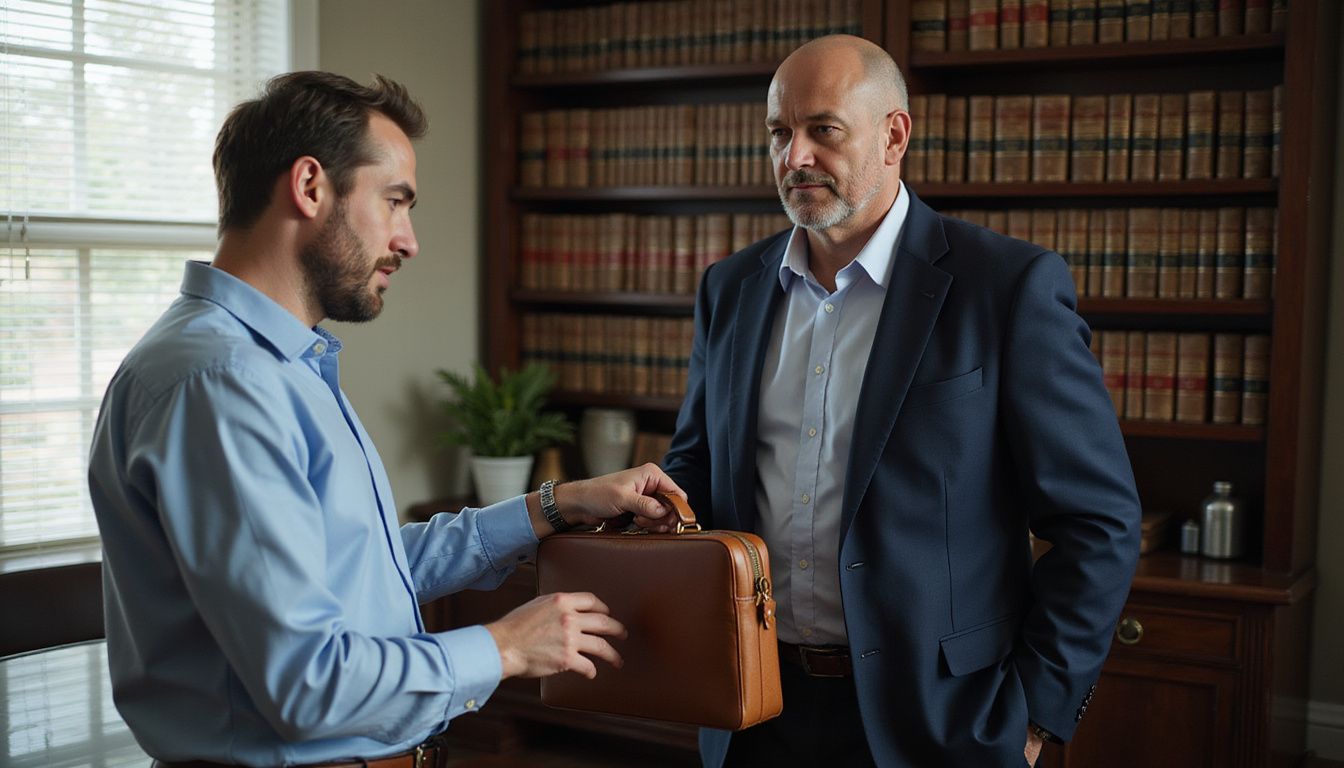Struggling with debt can feel overwhelming, leaving many wondering what comes next. In Canada, bankruptcy is a legal process designed to provide relief for individuals unable to pay their debts.
This article will guide you through understanding bankruptcy in Canada, from the basics of what it means to how it could potentially offer you a fresh financial start. Keep reading to learn if this path might be right for you.
Key Takeaways
- Bankruptcy in Canada is a legal process for those who can’t repay their debts, allowing them to start over.
- The Bankruptcy and Insolvency Act governs this procedure, and it involves working with a Licensed Insolvency Trustee.
- To qualify for bankruptcy, you must owe at least $1,000 and be unable to pay your debts as they come due.
- Filing for bankruptcy affects your assets, income, credit score, and could impact your spouse if there are shared debts.
- Alternatives like consumer proposals or credit counseling can help manage debt without going through bankruptcy.
Understanding Bankruptcy in Canada

Understanding bankruptcy in Canada is essential for those grappling with unsustainable debt, as it offers a legal remedy to reset one’s financial standing under the protection and structure of federal legislation.
It’s a process designed not just to relieve individuals from overwhelming liabilities but also to provide fair distribution to creditors.
Definition of bankruptcy
Bankruptcy is a legal status for people who can’t pay off their debts. It lets them start fresh by getting rid of these debts while being fair to creditors. Under Canada’s Bankruptcy and Insolvency Act, this process aims to help honest but unfortunate debtors clear their slate.
A person or business that declares bankruptcy admits they cannot meet financial obligations as they come due.
The law protects both the person in debt and the creditors involved. When declared bankrupt, you’re saying formally that you need help managing your debts. This declaration not only aids individuals but also ensures that all creditors get treated equally during the settlement process.
Purpose of bankruptcy
The goal of bankruptcy is to help people who can’t pay back what they owe. It allows them to start fresh by wiping away their debts. This process also makes sure all creditors get treated equally and justly.
Under Canadian law, it offers a way out for those who have honestly fallen on hard times. Bankruptcy gives these individuals a chance at a new financial beginning without the heavy burden of debt.
Canadian laws governing bankruptcy
In Canada, the Bankruptcy and Insolvency Act (BIA) sets the stage for all matters of bankruptcy. It’s a federal law meant to help people who can’t pay back their debts get a fresh start.
This act ensures that everyone follows the same rules across the country. Parliament has full control over these laws, as stated in Section 91(21) of the Constitution Act, 1867.
Provincial and territorial regulations also play a part in shaping how bankruptcies work locally, especially when it comes to what you’re allowed to keep. Property exemption laws vary from one region to another.
So while federal legislation provides the framework, local laws fill in important details about your assets during bankruptcy.
Who qualifies for bankruptcy?
You can file for bankruptcy if you owe more than $1,000 and can’t pay your debts. This rule helps people who are deep in debt and need a fresh start. Not just anyone can declare bankruptcy; there has to be a real inability to cover the bills.
A Licensed Insolvency Trustee is the only professional authorized to handle your bankruptcy filing. They guide you through each step, making sure everything goes smoothly according to Canadian law.
If you’re drowning in debt with no way out, this could be the lifeline you need.
The Bankruptcy Process

The bankruptcy process in Canada involves a clear and structured path guided by a licensed insolvency trustee to help you navigate the complexities of settling your debts – read on for an in-depth look at each step towards regaining your financial freedom.
Contacting a licensed insolvency trustee
Getting help with debt starts by reaching out to a licensed insolvency trustee. They are professional debt consultants authorized by the Office of the Superintendent of Bankruptcy (OSB).
- Find a trustee using the OSB’s online search tool.
- Make an appointment to discuss your financial situation.
- Gather and bring all necessary financial documents, such as bills, bank statements, and loan agreements.
- Expect honest advice on whether bankruptcy is the right choice for you.
- Learn about alternatives to bankruptcy during your meeting.
- Ask questions about fees, the process, and how long it will take.
- Follow their instructions for completing required forms and paperwork.
- Work with the trustee throughout the process to ensure all steps are followed correctly.
Filing the necessary paperwork
Filing the necessary paperwork is a crucial step in declaring bankruptcy in Canada. You will work with a Licensed Insolvency Trustee who helps you complete and submit the documents.
- Gather all your financial information, including credit card and bank statements, as well as mortgage records. This helps to paint a full picture of your financial situation.
- Meet with your Licensed Insolvency Trustee for a free debt assessment. They will discuss your options and the paperwork needed for bankruptcy.
- Complete forms that list all of your assets, debts, income, and expenses. Your trustee will provide these forms and guide you through them.
- Sign the necessary legal documents that your trustee prepares. These include an Assignment for the General Benefit of Creditors and a Statement of Affairs.
- Your trustee files the paperwork with the Office of the Superintendent of Bankruptcy (OSB). The OSB then officially records your bankruptcy.
- Provide additional details if required. Sometimes, more information about your finances may be requested by creditors or the court.
- Trustees send copies of your bankruptcy paperwork to creditors within five days. This allows creditors to file claims against you.
Commitments during bankruptcy
Bankruptcy is a legal process in Canada to help people who can’t pay their debts. During bankruptcy, you must do certain things to have your debts forgiven.
- Meet with a Licensed Insolvency Trustee (LIT). You provide them information about your money, property, debt, and regular expenses.
- Make monthly payments. Your income decides how much you pay.
- Attend two counseling sessions. These teach you about money management and rebuilding credit.
- Give up some assets. Not all your property is protected when you go bankrupt.
- Keep records of your finances. You must track and report your income and expenses to the LIT.
- Surrender credit cards. All cards must be handed over to the trustee.
- Stay in touch with the trustee regularly. Update them on any changes in your financial situation.
Duration of bankruptcy
Bankruptcy doesn’t last forever in Canada. Most people complete the process in nine to twenty-one months if it’s their first time.
- You’ll start by meeting with a licensed insolvency trustee.
- They will help you file all needed paperwork, starting your bankruptcy.
- After filing, you must fulfill certain duties for completion.
- These duties often include attending financial counseling sessions.
- During bankruptcy, a portion of your income might be required to be paid to the trustee.
- Once you’ve finished these steps, you may receive a “discharge.”
- A discharge means you are no longer responsible for the debts covered by bankruptcy.
- For first – time bankruptcies, this usually happens after nine months.
- If it’s not your first time, expect the process to take longer, between 24 to 36 months.
- An R9 rating appears on your credit report showing your bankruptcy status.
- This mark can remain there for six years after your discharge if it’s a first – time event.
- The clock starts once you get discharged from bankruptcy, not when you initially file.
Effects on assets, debts, income, and credit score
After completing the bankruptcy duration, it is important to understand how it affects your financial situation. Here is what happens to assets, debts, income, and credit scores:
- Assets: Some of your assets might be sold to pay off debt. Your trustee will explain which assets you can keep and which ones you may lose.
- Debts: Most of your debts will be wiped clean after bankruptcy. However, not all debts disappear; for example, child support and alimony are not affected.
- Income: If you make more money than a certain limit during bankruptcy, you may have to make additional payments to creditors.
- Credit score: Your credit score will take a hit after filing for bankruptcy. Expect a lower overall credit rating for about six to seven years from your filing date.
Impact on the spouse
Bankruptcy can change not just one person’s financial standing, but it also influences their partner’s situation. If your spouse files for bankruptcy, you won’t be held accountable for their debts unless you guaranteed or co-signed them.
However, joint debts like shared credit cards or loans remain a mutual responsibility. Even if you separate from your partner or get a divorce, these joint obligations will still tie both of you financially.
Your spouse does not have to go bankrupt just because you do. They won’t need to give their information to the Licensed Insolvency Trustee handling your case either. But keep in mind that bankruptcy could affect family property and debt divisions if you decide to part ways later on.
Also important is that certain responsibilities such as child support payments cannot be wiped clean through bankruptcy – they will always remain payable despite financial struggles.
Alternatives to Bankruptcy
4. Alternatives to Bankruptcy: Individuals seeking relief from overwhelming debt have options beyond bankruptcy, such as proposing a consumer proposal or exploring credit counseling services.
These alternative paths can provide the necessary financial restructuring without the full impact of a bankruptcy declaration.
Debt relief options
Understanding all your options for getting out of debt is important. Here are some alternatives to bankruptcy in Canada:
- Consumer Proposal: This program allows you to make a deal with your creditors where you pay back only a part of what you owe. It stops creditors from bothering you and lets you keep your assets.
- Consolidation loans: You can combine all your debts into one loan with a lower interest rate. This makes it easier to manage monthly payments and can save you money on interest.
- Credit counseling: Speak with a credit counselor who can help you understand your finances. They can also create a budget plan and sometimes negotiate with creditors on your behalf.
- Debt settlement: Reach an agreement with creditors to pay off a debt for less than the full amount owed. It may impact your credit but less than bankruptcy would.
- Selling personal assets: Raise money by selling things you own like cars or jewelry. Use this money to pay down debt directly, reducing what you owe quickly.
- Personal budgeting: Create a strict budget that cuts unnecessary expenses. Use the extra cash to pay off debts over time, avoiding the need for bankruptcy.
- Debt restructuring: Change the terms of your debt with lenders, possibly lowering interest rates or extending payment periods to reduce monthly payments.
Considerations before filing for bankruptcy
Think about other ways to handle your debts before choosing bankruptcy. You could try a consumer proposal, debt consolidation, credit counseling, or settling with creditors. Each of these options can offer a fresh start without the heavy impact of bankruptcy.
They may help you keep more control over your finances and assets.
Talk to an expert for advice on what path is best for you. Learn how making a proposal can affect your situation differently than filing for bankruptcy. Find out ways to rebuild your credit that fit your unique circumstances.
These steps are crucial in making an informed decision about managing debt and securing financial stability.
Conclusion
Bankruptcy is a legal way to wipe out debt when you can’t pay it back. It gives you a fresh start but affects your credit. You must work with a trustee and follow rules for this process.
Always explore other options before choosing bankruptcy.
FAQs
1. What is bankruptcy in Canada?
Bankruptcy in Canada is a legal process where someone who cannot pay their debts gets a new start.
2. Who can declare bankruptcy in Canada?
Any person or business that owes at least $1,000 and can’t meet their debt payments when they’re due can declare bankruptcy in Canada.
3. How do I file for bankruptcy in Canada?
To file for bankruptcy, you must work with a Licensed Insolvency Trustee who will guide you through the process and paperwork.
4. Will I lose everything if I go bankrupt in Canada?
No, certain items like clothing and household furniture are protected under Canadian law, but other assets may be sold to pay your debts.
5. How long does the bankruptcy process last in Canada?
Bankruptcy usually lasts about 9 months for first-time bankrupts without surplus income but could differ based on individual circumstances.




